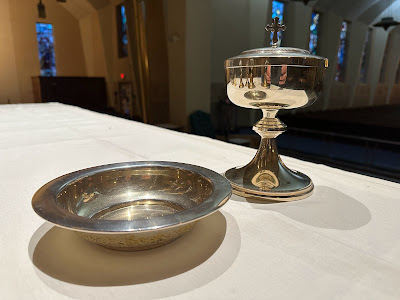 |
| First try & better bet |
A long time ago, it already seems, I consecrated all the congregational hosts in a large, deep paten, more of a bowl actually, that was directly before me throughout the action at the altar. During the pandemic I switched to having only the priest’s host on a flat paten in front of me, and all the others (the ones for y’all) at the back of the corporal in a ciborium, that is, a footed vessel with a lid. The lid is removed only at the consecration of the hosts, a short time with relatively few, carefully spoken words, so it protects the hosts from any contamination that might come from my mouth as I sing and speak at greater length and volume the extensive prayers proper to the altar.
The ciborium was for untold centuries the only permitted eucharistic container, with strict instructions for when the lid be removed. It is almost as if the Church understood that the food for the faithful needs to be protected and preserved both before and yes, even after it becomes the Body and Blood of Christ, to protect it from damage or infection. Freshly aware of my own ability to incur and transmit germs, I continue to use the ciborium.
When I was in middle school, my parish introduced the novel and fashionable practice of putting all the altar breads, or hosts, in open containers out on a table in the vestibule along with the large bowl in which they would be carried to the altar. Tongs were provided for parishioners to move “their” breads into the bowl. There was no such set-up by the other doors, so it never helped get the right number of hosts for those attending; but it added much-valued “participation.” It also added a great opportunity for contamination and mishap of every sort, and was abandoned after a few years.
Recent events have made me more aware of incongruities such as these that had filtered into our liturgical practice and fashioned our expectations over the past five decades. Resuming corporate worship after the lockdowns were eased then lifted presented a necessity of reevaluation for practical and sanitary, that is, health purposes.
Many people, even some of my own seminary classmates, look at me like I am crazy when I explain that the most safe and sanitary way to give someone the sacred host is on the tongue, especially to one who is kneeling. That is most likely because they have rarely if ever done it. For anybody my age or younger, reception on the hand was the only option their entire Catholic lives, and any thoughts of receiving onto the tongue was considered in terms of cooties or the plain weirdness of old people. But in reality, since circumstances made it part of my practice as a priest, only very, very rarely (once a year?) might there be disconcerting contact while communicating someone on the tongue.
And honestly, during those many long months when we were all working so hard not to have physical contact with other people, I realized how hard it is safely to lay our Lord into the wildly varied, unpredictably presented and occasionally grabby human hand without some flesh-on-flesh contact. It really helps if the communicant – the recipient – is holding still rather than moving toward me, which our current method of communion also achieves. But even that level of care that fails to take account of the inevitably direct link of the host in the hand, about to be consumed, with everything that the receiving hand has touched since last it was washed. Ick.
Which is also why I think it best not to shake hands right before communion, at least not with anybody not in your family or domicile, with whom you already share everything anyway. The liturgical handshake is a late 20th-century innovation anyway; for millennia the “kiss of peace” involved hands placed on shoulders or elbows, and cheeks passing one another like ships in the night. A genial and gracious bow would be a prudent offering.
None of these practices guarantee your safety; I hope most of us realize just how that catchphrase can be and has been misused to manipulate our minds and behavior. They are, however, a considered and careful praxis that minimizes unnecessary and unhealthy sharing while making available the unimpeded physicality and communality of our sacramental salvation.
That large, deep paten, more of a bowl actually, that I formerly used for all parish Masses was one I had commissioned to be made for my use before I left Rome for priestly ordination. The impractical, unsanitary vessel is in storage, but with me every day are the words I had inscribed arounds its edge, one of the three admonitions from the ordination rite: Conform your life to the mystery of the Lord’s Cross.